Range Rover Evoque: System Operation
PRINCIPLES OF OPERATION - PARKING AID
Vehicles Fitted With Automatic Transmission
If reverse ) is the first gear selected after the ignition is switched on, both the front (if fitted) and rear parking aid sensors will become operational. If a forward drive gear is subsequently selected, the front parking aid sensors only will remain operational until vehicle speed increases above 16 km/h (10 mph), park (P) is selected or the PDC control switch is pressed.
If drive (D) is the first gear selected after the ignition is switched on the parking aid system will have to be activated by pressing the PDC control switch.
NOTE: The PDC system can not be activated whilst the vehicle is in park (P).
Vehicles Fitted With Manual Transmission
If reverse ) is the first gear selected after the ignition is switched on, both the front (if fitted) and rear parking aid sensors will become operational. If a forward drive gear is subsequently selected, the front and rear parking aid sensors will remain operational until vehicle speed increases above 16 km/h (10 mph), or the PDC control switch is pressed.
If a forward gear is the first gear selected after the ignition is switched on the parking aid system will have to be activated by pressing the PDC control switch.
Audible Warnings
The control module processes the distance readings from the ultrasonic parking aid sensors to determine if there are any objects within the detection areas. If there are no objects no audible warning will be emitted. If an object is detected, repeated audible warnings are emitted via the audio system speakers. The time delay between the audible warnings decreases as the distance between the detected object and the vehicle decreases until eventually a continuous tone is emitted from the audio system speakers.
Distance Calculation for Audible Warnings
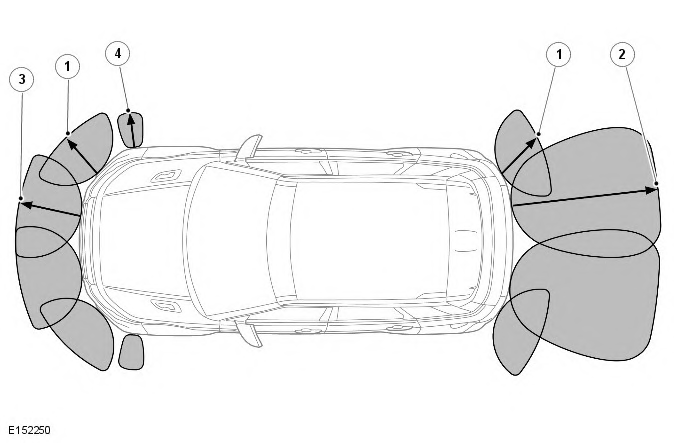

Detection Calculation
In the combined mode, the sensors emit a series of ultrasonic impulses and then switch to receiver mode to receive the echo reflected by an obstacle within the detection range. The received echo signals are amplified and converted from an analogue signal to a digital signal by the sensor. The digital signal is passed to the parking aid module and compared with pre-programmed data stored in an EEPROM (electrically erasable programmable read only memory) within the module. The module receives this data via the signal line from the sensor and calculates the distance from the object using the elapsed time between the transmitted and received impulse. The duration of the impulse duration is determined by the module, with the sensor controlling the frequency of the impulse output.
In receiver mode, the sensor receives impulses that were emitted by adjacent sensors. The module uses this information to precisely determine the position and distance of the object.
If no objects are detected there are no further warning tones. If an object is detected, repeated audible tones are emitted from either the front or rear audio speakers as appropriate. The time delay between the tones decreases as the distance between the object and the vehicle decreases, until at approximately 300 mm (12 inches), the audible tone becomes continuous.
After the initial detection of an object, if there is no decrease in the distance between an object and the central sensors, the time delay between the audible warnings remains constant. If an object is detected by one of the corner sensors only, the audible warnings stop after approximately 3 seconds if there is no change in the distance between an object and the corner sensor.
When approaching several objects within detection range, the control module recognises the distance from the vehicle to the nearest object.
The PDC module will prioritise the objects detected, the nearest object detected will take priority and the corresponding audio outputs will be emitted. For example if 2 objects are detected (one front one rear) the nearest detected object will take priority and relevant audible tone will be heard.
If two objects are detected at equal distance (one front one rear) the audible tones will alternate between the front and rear audio speakers.
The volume output of the parking aid audible tones can be adjusted using the audio volume control when the PDC is activated, the volume can also be adjusted from the home menu screen by selecting 'Setup', 'System' followed by 'Volume Presets' on the TSD. The volume can be adjusted using the + or - selections on the TSD.
The parking aid module receives a signal on the CAN from the CJB when a trailer is fitted. When this signal is detected, the parking aid module suspends operation of the rear PDC system.
NOTE: The ignition needs to be cycled once the trailer has been disconnected to activate the rear parking aid system.
Diagnostics
The control module has a diagnostic connection via the high speed CAN bus to enable faults to be retrieved using the Land Rover approved diagnostic equipment. Additionally an on-board diagnostic routine within the control module constantly monitors the system and alerts the driver to a system fault by emitting a 3 second continuous tone through the front audio speakers when the ignition is switched on. The control switch LED will also flash 6 times when reverse gear is selected or the PDC switch is pressed.
PRINCIPLES OF OPERATION - PARK ASSIST
The park assist feature assists the driver to parallel park their vehicle. Once the system has identified a parking space using its ultrasonic sensors, it automatically steers the vehicle into place, the driver continues to brake, accelerate and select the correct gear. Informative graphics and messages are displayed in the instrument cluster message center, to guide the driver through each stage of the maneuver.
Vehicles with park assist have a separate switch to activate the system.
Park assist solely uses ultrasound sensors:
- Four sensors in the front bumper (park aid sensors)
- Two further sensors positioned on either side at the front of the vehicle to detect available spaces.
- Four sensors in the rear bumper (park aid sensors)
The park assist system is active when the following input conditions exist:
- The park assist switch is activated. The switch is illuminated by a amber LED (light emitting diode), powered by the PDC (park distance control) module. The switch is hardwired to the module
- The vehicle is travelling forwards below 18 mph (30 km/h). Vehicle speed information is sourced from directional wheel speed sensors via HS CAN communication from the ABS module to the PDC module.
The park assist sensors are hardwired to the PDC module. Scanned information is constantly transmitted to the module.
Once a parking space has been identified the PDC module calculates the parking trajectory, communicating output information to the following vehicle systems:
- The EPAS (electric power assisted steering) module via HS CAN. The trajectory calculations are processed by the EPAS module ready for the first stage of the parking maneuver. Once a vehicle speed signal is received (vehicle reversing) the EPAS module independently controls the steering trajectory.
- The instrument cluster message center via HS CAN. The message center displays the relevant park assist information/instructions to the driver
- The CJB via HS CAN which 'gateways' front and rear park aid sensor
information to the Touch-screen via MS CAN.
The Touchscreen 'gateways' the sensor information to the AAM (audio amplifier module) via the MOST ring. The audible warning tones are emitted through the audio system speakers.
Service Information
If the self check system fails the following warnings apply:
- The instrument cluster displays an error message
- The front audio system speakers will emit a 3 second continuous tone
- A DTC (diagnostic trouble code) is logged in the PDC module.
If a sensor failure is detected:
- The front audio system speakers will emit a 3 second continuous tone
- The instrument cluster displays an error message
- A DTC is logged in the PDC module.
Searching for a Parking Space
Once the driver has identified a possible parking space the park assist system carries out the following checks and procedures:
- The system constantly searches for a space on the passenger side of the vehicle. Space on the driver's side is searched via instruction from direction indicator operation.
- As the vehicle moves forward, parallel to a row of parked vehicles, it detects the parked vehicles.
- The system can detect a space up to four meters away from the side of vehicle. The system will only select a space which is 1.2 times the length of the vehicle (or greater) and deep enough to park the vehicle.
- When the vehicle detects a sufficient size parking space, the driver is instructed to stop the vehicle and select reverse gear.
- The system calculates the appropriate trajectory to park the vehicle into the detected space.
NOTE: If the driver is in slow moving traffic the system will be activated frequently when passing by other vehicles.
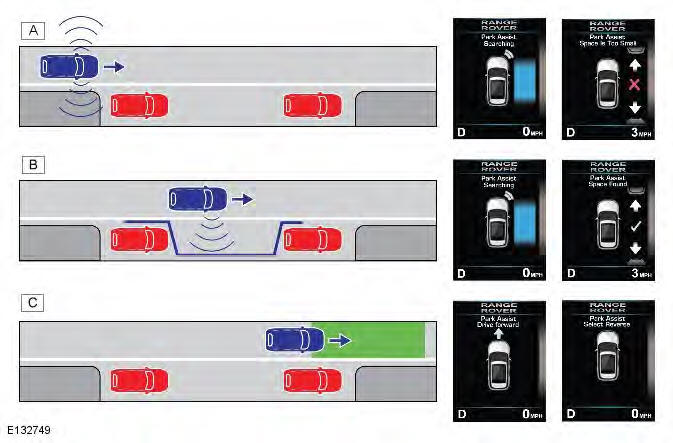
- Park assist system activated searching for space
- Park assist detects and measures space
- Vehicle comes to end of space and stops ready for next state.
Reversing into Space
When reverse gear is selected the instrument cluster message center displays the appropriate parking instructions.
The following checks and procedures are applied:
- The driver follows message center instructions, moving the vehicle backwards along the trajectory calculated by the park assist system
- Detected obstacles at 0.9m generate an intermittent sound tone over the vehicle rear speakers
- Detected obstacles at 0.3m generate a constant sound tone over the vehicle rear speakers
- On reaching the end of the reversing maneuver the driver is instructed to apply the footbrake to stop the vehicle
- The driver selects a forward gear to prepare for the next stage of the parking maneuver
- If the vehicle has been parked in a large space the maneuver is complete and the system operation ends.
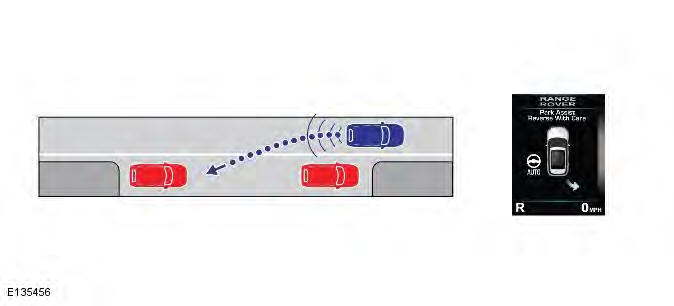
Driving Forward within Space
If the vehicle is not in the correct position after the initial reversing maneuver, the driver is instructed to select a forward gear.
When the forward gear is selected, the instrument cluster message center displays the appropriate parking instructions.
The following checks and procedures are applied:
- The driver follows message center instructions, moving the vehicle forwards along the trajectory calculated by the park assist system
- Detected obstacles at 0.4m generate an intermittent sound tone over the vehicle front speakers
- Detected obstacles at 0.3m generate a constant sound tone over the vehicle front speakers
- On reaching the end of the forward maneuver the driver is instructed to apply the footbrake to stop the vehicle
- The driver selects reverse gear to prepare for the next stage of the parking maneuver
- If the vehicle is in the final position the maneuver is complete and the system operation ends.
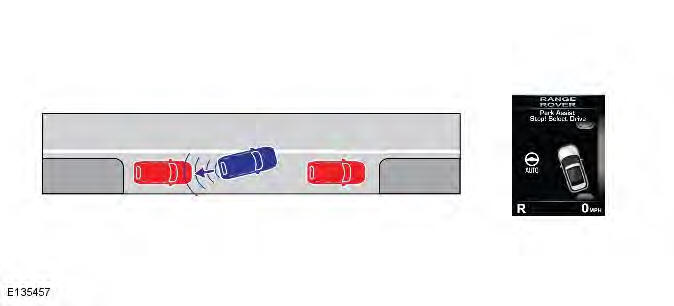
If the vehicle is parking in a smaller space more shuffling may be required to complete the parking maneuver.
Driver selects forward gear - further shuffling is completed
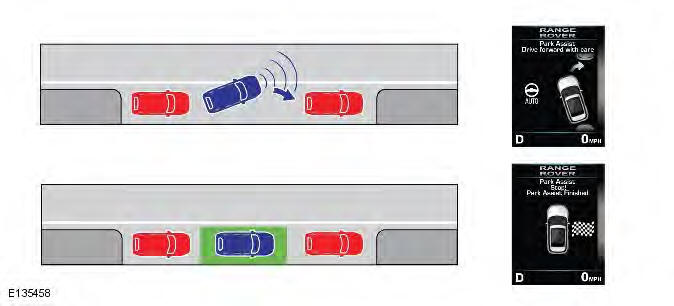
Completion of Parking
Once the system has detected the vehicle is parked in the final position the message center informs the driver the park assist function is complete. The driver selects neutral/park gear position and switches off the engine.
The park assist system is configured to operate a maximum of seven maneuvers, with each movement counting as one maneuver. This is more than adequate as most park assist maneuvers are complete and the vehicle is in the final parking position within four reverse and forward movements.
PRINCIPLES OF OPERATION - CAMERA SYSTEM
Lo-Line Camera System
A shielded co-axial cable connection between the camera and the Touch Screen Display (TSD) is used for the video image transmission.
The camera receives power at all times when the ignition is in power mode 6 or 7. When reverse is selected, the camera then sends a message to entertainment system requesting for the image to be displayed on the TSD.
When reverse gear is deselected, the camera image remains on the TSD for 5 seconds after the transmission has been put into drive 'D', 'P', 'N', or 'S'. This is to prevent the TSD switching between screens if the vehicle is being manoeuvred into a parking space. If the vehicle forward speed exceeds 16 km/h (10 mph) within the 5 second period, the camera image is removed from the TSD.
If the TSD display is switched off, the camera image will be automatically displayed when reverse gear is selected. When reverse gear is deselected and the 5 second period has expired, the TSD will revert back to its switched off state.
Lo-Line Rear View Camera
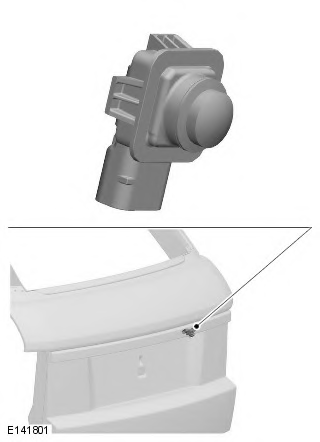
The rear view camera provides additional information to the driver when reversing the vehicle. When reverse gear is selected the camera integrated into the tailgate handle, automatically displays a wide-angle color image of the view from the rear of the vehicle onto the TSD.
Overlay graphics are displayed by a combination of signals received on the medium speed CAN to the TSD.
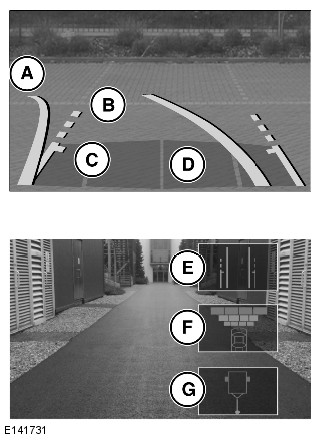
- Solid line: The projected path based on current steering wheel position.
- Dotted line: The safe working width of the vehicle (including exterior mirrors).
- Tailgate access guideline: Do not reverse beyond this point if tailgate access is required.
- Parking sensor activation: A colored area appears, to indicate which rear sensor(s) has been activated.
- User option. Touch to enable/disable A, B & C.
- User option. Touch to enable/disable D.
- User option. Touch to enable/disable Hitch Assist guidance lines.
Tow Hitch Assist
The rear view camera provides additional information to the driver when hitching a trailer to the vehicle. When reverse gear is selected the camera integrated into the tailgate handle assembly, automatically displays a wide-angle color image of the view from the rear of the vehicle onto the TSD (touch screen display).
Within the settings menu the driver can activate the Hitch Guidance feature. Hitch guidance provides a trajectory line indicating the path of the towball in relation to the steering angle applied to the vehicle.
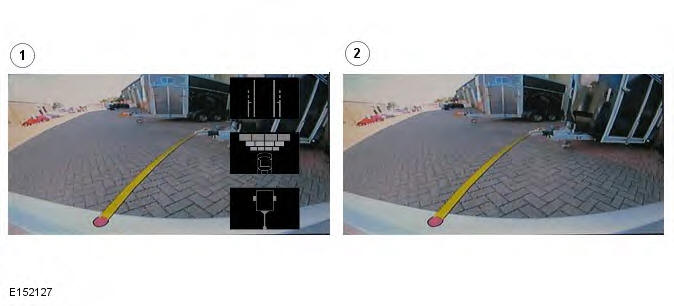
- Touch Screen Display - Rear view menu screen
- Tow ball trajectory line
Hi-Line Camera System
The proximity camera system provides the driver with a visual-aid when maneuvering the vehicle at low speeds. The system uses a dedicated control module to capture the camera data and display the resulting images on the TSD (Touch Screen Display), providing the driver with a 360

